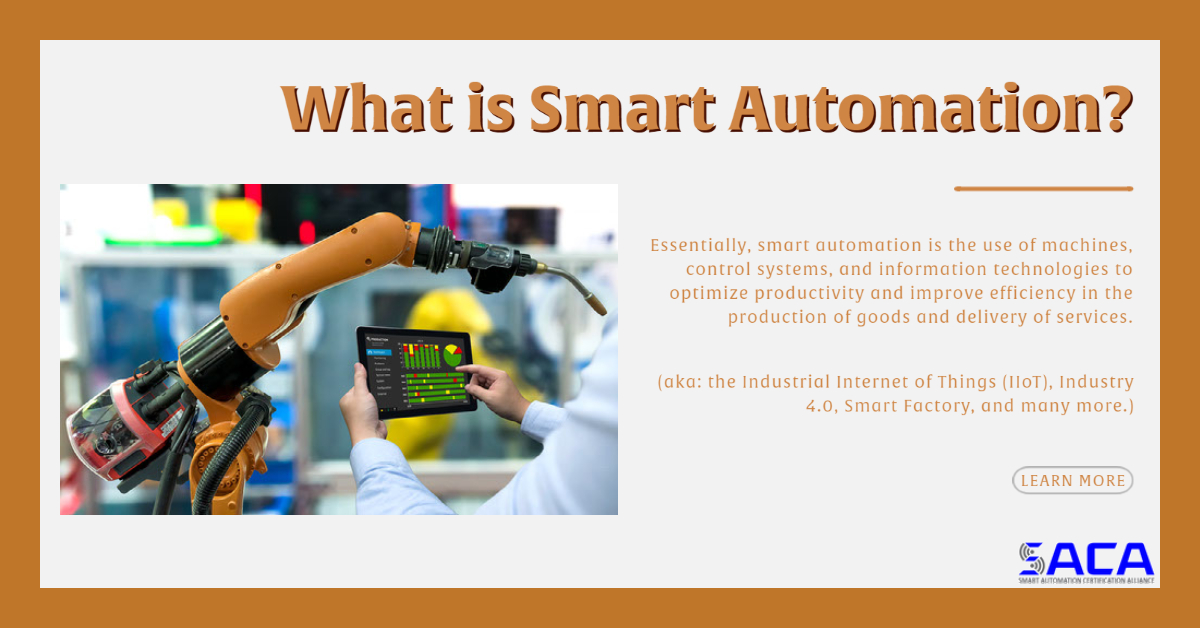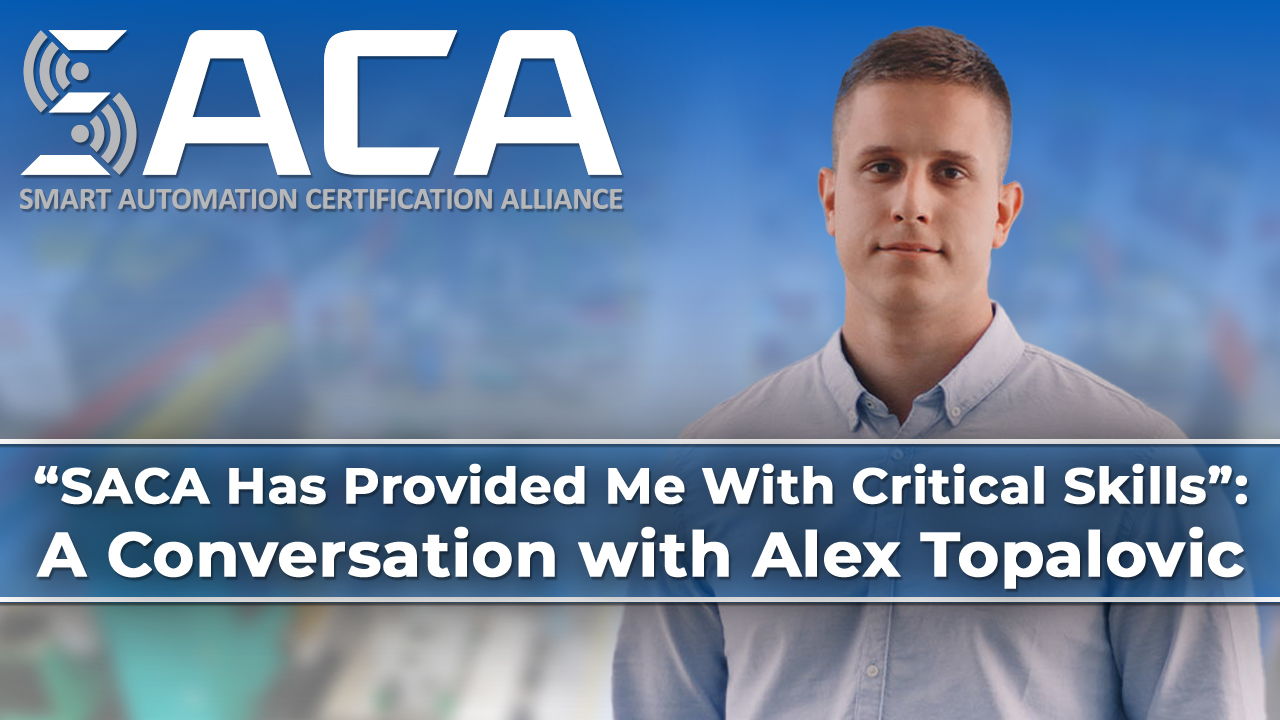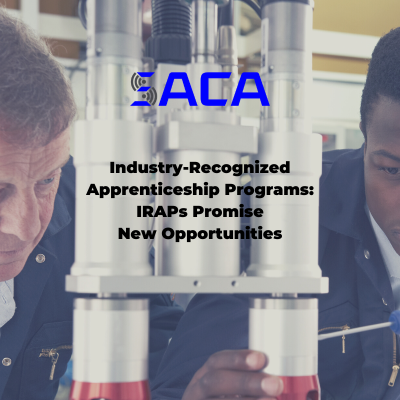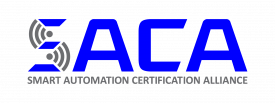“SACA Has Provided Me With Critical Skills”: A Conversation with Alex Topalovic
Alex Topalovic, a Project Manager at northern Indiana-based enFocus and recent Conexus Rising 30 award recipient, completed SACA C-101 and C-102 certifications in the spring of 2022 at the Ivy Tech -Elkhart/South Bend campus. We sat down with him to discuss why he chose to pursue SACA certifications and how he believes they’ve strengthened his understanding of advanced manufacturing and logistics (AML).
Topalovic is a native of Belgrade-Serbia, studied Global Management (‘19) at Earlham College in Richmond, Indiana, and then received a master’s degree from the Massachusetts Institute of Technology (MIT). Topalovic also completed internships at the Richmond Baking Company and Fiat Chrysler Automobiles, competed in supply chain competitions at ASCM Deloitte and Conexus Rolls-Royce, and co-founded Digital Leader, an IT startup / platform that helps high school teachers develop digital leadership and technology skills among their students.
Topalovic is also a recent winner of the Conexus Rising 30 award given to people under 30 years of age that are “bringing exceptional leadership and innovative thinking to bear on [advanced manufacturing and logistics] toughest challenges.” Conexus Indiana is a non-profit initiative that facilitates industry, academic, and public sector partnerships to position “the Hoosier State as the best place for advanced manufacturing and logistics industries to innovate, invest, employ and succeed.” Of the award, Topalovic said, “Conexus has allowed me to make several connections in the state and work to further bettering Indiana’s manufacturing industries.”
Currently working as a Project Manager at enFocus, Topalovic has been praised for playing a key role in actionable process improvements to “sharpen supply chain, manufacturing, R&D, and market access,” including the deployment of Transformation XP, which “helps companies improve on-time delivery, reduce stock outages, increase revenue, and improve customer satisfaction.”
“I work for enFocus because there are many opportunities in AML in the state of Indiana,” says Topalovic, “so I help with talent development and recruitment to the state. Working with organizations like the University of Notre Dame and the Eli Lilly Endowment, Inc., we create innovative research projects to attract and retain talent in South Bend area.” Specifically, in regards to Notre Dame, Topalovic works with iNDustry Labs, the university’s platform for collaborating with local industry.
SACA Certifications
Manufacturers looking to improve efficiency and increase productivity are increasingly looking to advanced Industry 4.0 technologies to automate their operations and processes. Technologies like artificial intelligence are transforming modern manufacturing facilities, but their adoption is not without hurdles.
In the spring of 2022, Topalovic completed Gold Certifications in C-101 (March 23,2022) and C-102 (May 17, 2022) within the Ivy Tech’s Smart Manufacturing and Digital Integration program. Topalovic says that his past experience with Rolls Royce and Deloitte Fiat prompted him to attain SACA certifications so that he could better understand the concepts and skills outlined in the C-101 and C-102 Credentials.
“SACA has provided me with critical skills through hands-on training, curriculum, and multimedia. I like the Silver and Gold certifications and the clear pathways through the program to achieve industry specific skills,” says Topalovic. Further, he said, “I like how the clear understanding of certification hierarchy levels, hands-on training skills, and curriculum follow the course well.”
Not only was Topalovic satisfied with his SACA experience, but he’s also said that he’s looking forward to attaining higher level SACA credentials in the future and has recommended SACA certifications. “I see several other businesses using SACA certifications. I have recommended these certifications to several co-workers.”
Topalovic particularly praised the Gold-level SACA certifications, which reinforce skills with hands-on practice and ensure that people can demonstrate practical application of the skills that they have learned: “Amatrol training equipment and materials helped with understanding course content. The equipment provided by Amatrol in Ivy Tech Training facility was of high quality and amazing how it was able to teach all the course concepts. This differs from other certifications I have taken in the past which do not have equipment to supplement course content.”
Overall, Topalovic not only has an optimistic outlook on SACA Certifications and their application, but the future of AML in the state of Indiana as a whole:
“Indiana’s business friendly practices coupled with strong emphasis from government leadership and organizations including Conexus to promote Advancing AML have led to Indiana being one of the leading manufacturing states. Indiana is a great state with great culture. The people work extremely hard and the industries surrounding Northern Indiana provide many opportunities for professionals to Advance their career in AML. Manufacturing is vital to Indiana’s economy and ranks as one of the top states in nation in relation to the percentage of state GDP. I am very proud to be a part of this!”
To learn more about SACA, please download our brochure or read an interview with our Executive Director, Jim Wall.
- Published in News, Technology
Helpful tips on how to build a smart automation résumé
To view a multimedia version of ‘Helpful tips on how to build a smart automation résumé‘, please click here.
New year, new you – right?
With the end of 2020 approaching quickly, many are circling Jan. 1, 2021 as an opportunity to improve their happiness and wellbeing. For some, that signals a career change – a way to improve on their daily professional grind.
While COVID-19 has made the job market volatile, there are still careers out there with jobs waiting for people to apply for them. And some of those jobs happen to fall into a sector known as Smart Automation.
What is Smart Automation?

While some know the term as “smart automation”, it goes by many different monikers: the Industrial Internet of Things (IIoT), Industry 4.0, Smart Factory, and many more.
Essentially, smart automation is the use of machines, control systems, and information technologies to optimize productivity and improve efficiency in the production of goods and delivery of services. From building automobiles to sewing buttons on a shirt, it is used all around the world to improve the speed and quality of manufacturing. However, what makes the automation “smart” is a lot like the same idea used when describing smartphones: we are connecting to the Internet of Things (IoT), which allows devices to communicate with other devices via the Internet.
This has ushered in a brand new way of manufacturing, which many are viewing as the Fourth Industrial Revolution – which explains the name Industry 4.0. Smart automation holds the potential for a massive impact on industrial efficiency and proficiency. By combining cyber-physical systems, automation, and the Internet of Things, companies can begin to create a smart factory environment, which could include a team of robots communicating with each other (and human workers) to report on a wide variety of information, such as cycle times, mechanical breakdowns, predictive maintenance, and more.
Why should I be interested in a career in Smart Automation?
While the real boost behind smart automation involves robots and self-driving vehicles, it does not leave human workers out in the cold. As an increase in usage of robots happens, low-skill assembly line-type jobs will begin to fade out, making ways for new careers that have never existed before.
The demand for these highly-skilled workers that can program, analyze, and maintain many parts of these complex systems is so tremendous that companies are having difficulty finding candidates to accept these careers in manufacturing, which has led to a sector-wide hiring struggle, known as the Skills Gap. This means these jobs – many of which are high-paying – are going unfilled due to the lack of qualified workers.
But smart automation doesn’t just live on an assembly line floor. In fact, thanks to the use of smart sensors, smart devices, and other new cutting-edge technologies, which possess the ability to create an enormous amount of data to be monitored and shared via cloud technology, many of the jobs available today require just as much knowledge on IT and cyber-security as any other typical manufacturing skill.
How do I build a résumé for jobs that don’t exist?
Like most jobs, you don’t pick a career by simply liking its name or title: you pick your career based on the skills that you’re good at, or enjoy doing. So with that in mind, here are four tips on how you can improve your smart automation résumé:

Tip #1: Spotlight on your “smart” skillset
By highlighting your “smart” skills – and highly-coveted personal skills like problem solving, critical thinking, and others – as opposed to a particular job’s title, you will be more adept to finding the ideal job for your skillset.
So when constructing your résumé, put an emphasis on your “smart” skillset that showcases you have the specific knowledge and know-how for the skills they are looking for. According to a recent study by Deloitte, many of the future jobs will revolve around these skills:

Tip #2: Include a focused professional summary statement
When introducing yourself through your résumé’s Professional Summary section, include any pertinent industry-needed skills that were called out in the company’s job listing. (Called “value proposition”, highlighting a collection of skills you can provide curated to a particular business or position makes you a more attractive candidate in the process.)
Be straightforward in explaining your skillset, and what you can offer this specific company. Not only will it showcase your most important attributes as early in the review process as possible, but it will also prove to the company that you took the time to study the job listing, not just submitting résumés blindly without reading.
Also, focus on strong character traits that prove your experience, and back it up with accomplishments. Remember to show, not just tell, examples of how you can improve their bottom line. If warranted, consider a compelling statement that describes your current (or previous) profession, especially if they include the “buzzword” skills a company is specifically looking for.

Tip #3: Don’t overlook your training – it matters!
Whether it’s your first career in industry, or you’re retooling for a future position or promotion, training in smart automation matters. From the bedrock knowledge of automation, to understanding all of the safety protocols around these automated machines, having industry-relevant training is critical for positions like these.
So when compiling your previous academic or professional experience, make sure to list any related classroom experience, as well as specific courses that pertain to the position you’re applying for – remembering to focus on your skillset.
If it applies to you, consider adding any apprenticeships, mentorships, or other non-traditional means of training. Don’t overlook any of your training, no matter how menial you might think it is.

Tip #4: Certifications can make (or break) your job search
Let’s be honest here: if Candidate A and Candidate B both have similar skillsets, experience, and recommendations – but only one of them holds an industry-recognized Industry 4.0 certification – it should be pretty clear who is going to get the first job offer.
Most Industry 4.0 or Smart Certifications can showcase to businesses that you are trained under the standard guidelines established by industry leaders. In fact, most companies will prioritize candidates that hold an official industrial certification from an industry-recognized institute, like SACA, for example.
Since these certifications play such a crucial role in the hiring process, consider upping your training regime to include industry-recognized smart credentials.
Getting involved with Industry 4.0 is a “smart” bet
In summary, it’s simple: Industry 4.0 jobs are aplenty, high-paying, and there for the taking.
But they’re not for everybody. These jobs take a specific skillset that rely heavily upon critical thinking and problem-solving. The challenges, though, should not dissuade someone from pursuing a career in smart automation. Instead, it highlights the pressing need for qualified workers in this field of work, and the unlimited possibilities these positions could bring to a world of “smart” manufacturing.
- Published in News
Industry-Recognized Apprenticeship Programs: IRAPs Promise New Opportunities
LOUISVILLE, KY—OCTOBER 14, 2020
Industries across the United States have been struggling for years to fill open positions with qualified workers. Despite widespread recognition of the problems industries face, the skills gap has continued to widen.
Rather than bringing new solutions, 2020 instead saw a global pandemic make an already-tough jobs situation worse. Due to the COVID-19 crisis, millions of American workers have lost their jobs, many of them permanently.
As the U.S. seeks to recover from “the most devastating economic crisis since the Great Depression,” there is no shortage of problems that must be addressed and solutions that need to be formulated. How effective those solutions are will dictate the speed and scope of economic recovery.
Unlike past economic recovery initiatives that often pushed people toward college degrees, experts believe that our current economic recovery from the COVID-19 Recession must instead focus on practical skill development for jobs industries need. To that end, community colleges and skills training may play a critical role.
Another potential solution with a proven track record of success is apprenticeship. In fact, many believe new industry-recognized apprenticeship programs (IRAPs) will provide fresh opportunities for both American workers and industries that desperately need skilled talent. How? IRAPs will expand the use of the apprenticeship model to industries that haven’t used it or have underutilized it in the past.
What Are IRAPs?
So what exactly are IRAPs anyway? According to the U.S. Department of Labor’s (DOL) Apprenticeship.gov website:
“Industry-Recognized Apprenticeship Programs are high-quality apprenticeship programs recognized as such by a Standards Recognition Entity (SRE) pursuant to the DOL’s standards. These programs provide individuals with opportunities to obtain workplace-relevant knowledge and progressively advancing skills. IRAPs include a paid-work component and an educational component and result in an industry-recognized credential. An IRAP is developed or delivered by entities such as trade and industry groups, corporations, non-profit organizations, educational institutions, unions, and joint labor-management organizations.”
For example, the Smart Automation Certification Alliance (SACA) was recognized as one of 18 initial organizations designated as an SRE by the DOL on September 23, 2020. SACA may now evaluate and recognize IRAPs consistent with DOL standards.
What are those standards? According to the DOL’s IRAP Fact Sheet, high-quality IRAPs must meet the following 10 requirements:
- Paid Work
- Written Training Plan
- Written Apprenticeship Agreement
- Specialized Knowledge and Experience
- Safety
- Equal Employment Opportunity
- Credit for Prior Knowledge
- Mentorship
- Industry-Recognized Credentials
- Disclosure of Costs and Fees.
When Were IRAPs Created?
IRAPs are a relatively-new solution in the area of workforce development. Their history can be traced back to June 15, 2017, when President Trump issued an Executive Order to Expand Apprenticeships in America.
According to a DOL press release, the order established the 20-member Task Force on Apprenticeship Expansion, which was “headed by the Secretary of Labor and co-chaired by the Secretaries of Commerce and Education.”
The DOL’s IRAP Fact Sheet notes that the president’s order “directed the Secretary to consider proposing regulations that promote the development of apprenticeship programs by third parties…especially in sectors where apprenticeship programs are insufficient.”
The Task Force subsequently recommended the establishment of IRAPs in May 2018. Eventually, as the IRAP Fact Sheet notes:
“To address America’s skills gap and to rapidly increase the availability of high-quality apprenticeship programs in sectors where apprenticeship opportunities are not widespread, the [DOL] has issued a Final Rule that establishes a system for advancing the development of high-quality IRAPs.”
IRAPs then became official when new regulations took effect on May 11, 2020.
How Do IRAPs Differ from Traditional Apprenticeships?
According to a recent Forbes article by Ryan Craig:
“For years, policy makers have struggled with the question of how to expand apprenticeships from traditional blue collar building and industrial trades to fast-growing sectors like technology, healthcare, and professional services. On a per capita basis, the U.S. is far behind other nations: Germany has nearly 20x as many apprentices, and the UK has 14x.”
Craig further notes that the goal of IRAPs is:
“to increase the number of actual American apprentices from 500,000 to 5 million by decentralizing apprenticeship authority from the DOL to hundreds of third party IRAP authorizers [SREs]…The expectation is that while DOL registered apprenticeships are infamous for the amount of paperwork required, IRAPs will be much less onerous and therefore more popular.”
Rather than taking apprenticeships in an entirely new direction, IRAPS are “intended to run in tandem with the department’s long-established registered apprenticeship program,” according to an article from the Community College Daily website. Indeed, the DOL’s IRAP FAQ clearly notes:
“IRAPs and RAPs [Registered Apprenticeship Programs] will work on parallel tracks with the support of the Department. The Registered Apprenticeship system has produced successful results in many industries for over 80 years and it will continue to do so. The industry-led, market-driven approach outlined in the IRAP final rule will give employers and other stakeholders the additional flexibility necessary to expand the apprenticeship model into new industries where registered programs are less prevalent and to address the diverse workforce needs of different industries and occupations. IRAPs provide a new apprenticeship pathway that lets industry organizations take the lead in identifying high-quality apprenticeship programs and opportunities based on the needs in their industry.”
Consistent with the goal of expanding the apprenticeship model to new industries, one notable difference between IRAPs and RAPs is that SREs are prohibited from recognizing IRAPs in the construction industry. According to article by Katie Spiker from the National Skills Coalition:
“This carve out was…the subject of a massive campaign by the building trades unions…According to proponents of the construction industry exclusion, and the Department in their justification of excluding construction in the final IRAP rule, the fact that the majority of U.S. apprenticeships are in the construction industry is evidence the model is effective for the industry and that expanding IRAPs to construction is not necessary to meet the goal of expanding apprenticeships in the U.S.”
Who Will Benefit from IRAPs?
The DOL clearly outlines a set of expected benefits to both workers and businesses in its IRAP Fact Sheet. For businesses, the DOL expects IRAPs to:
- provide an additional pathway to assist career seekers and job creators;
- serve the needs of business by expanding apprenticeships across more industries;
- use innovative, industry-driven approaches to scale a proven workforce education model;
- allow more flexibility to design apprenticeship programs that meet business needs; and
- supply an immediate pool of workers for today and skilled talent for tomorrow.
For workers, IRAPs are expected to:
- offer opportunities to earn and learn, while obtaining valuable, portable, industry-recognized, competency-based credentials;
- provide training in standards that are developed by the industry, ensuring an apprentice develops the skillset needed for career success;
- increase the opportunities for apprenticeship programs across all sectors in the economy; and
- provide an alternative to college for finding career success that allows workers to obtain high paying jobs without going into debt.
Katie Spiker echoes the view that both workers and businesses should benefit from IRAPs: “The IRAP initiative is evidence of the need to modernize apprenticeship, expand access to workers to earn industry-recognized credentials and allow businesses to play more of a role in helping tailor the kind of training their workers receive to meet their specific needs.”
While traditional registered apprenticeship programs have been successful for years, Roy Maurer notes in a recent article for SHRM, the Society for Human Resource Management, that “only about 0.2 percent of the U.S. workforce has taken advantage of the programs, primarily in trades and construction.” The DOL believes IRAPs “will effectively expand apprenticeship in telecommunications, health care, cybersecurity and other sectors where it’s currently not widely used.”
Rachel Greszler, senior policy analyst at The Heritage Foundation, believes the benefits to workers are clear:
“The [IRAPs] rule is an important step in opening up more nontraditional and affordable education opportunities that could particularly benefit younger Americans who have been left behind by America’s higher-education system, as well as current workers who have been negatively impacted by changes in industry and technology. It’s not in everyone’s best interest to pursue an expensive four-year college education, and these types of apprenticeships make it possible for individuals to obtain the education they need for a promising career without taking on debt, and instead, actually being paid in the process.”
As U.S. Labor Secretary Eugene Scalia summarized in a DOL press release:
“As workers seek to reenter the workforce following the economic disruption caused by coronavirus, [IRAPs] and the SREs that recognize them will provide new opportunities for Americans to earn a living while learning the skills needed in a changing job market.”
Where Can I Learn More About IRAPs?
According to Ryan Craig:
“There are millions of unemployed workers whose jobs are unlikely to return once the pandemic subsides. So one of the most important policy questions in America today is how they’ll find paths back to work…If there is an answer, apprenticeships will almost certainly play a leading role.”
If you want to learn more about IRAPs and the SREs who will be helping to bring them to life, be sure to check out the DOL’s Apprenticeship.gov website. The latest information and developments will be posted there as IRAPs take shape and begin to fulfill the goal of expanding apprenticeships into new industries while helping workers gain new skills.
- Published in News





